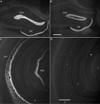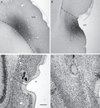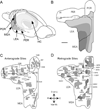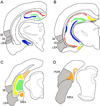Hippocampal and subicular efferents and afferents of the perirhinal, postrhinal, and entorhinal cortices of the rat
- PMID: 23872326
- PMCID: PMC3792719
- DOI: 10.1016/j.bbr.2013.07.005
Hippocampal and subicular efferents and afferents of the perirhinal, postrhinal, and entorhinal cortices of the rat
Abstract
Available evidence suggests there is functional differentiation among hippocampal and parahippocampal subregions and along the dorsoventral (septotemporal) axis of the hippocampus. The aim of this study was to characterize and compare the efferent and afferent connections of perirhinal areas 35 and 36, postrhinal cortex, and the lateral and medial entorhinal areas (LEA and MEA) with dorsal and ventral components of the hippocampal formation (dentate gyrus, hippocampus cornu ammonis fields, and subiculum) as well as the presubiculum, and the parasubiculum. The entorhinal connections were also characterized with respect to the LEA and MEA dentate gyrus-projecting bands. In general, the entorhinal connections with the hippocampal formation are much stronger than the perirhinal and postrhinal connections. The entorhinal cortex projects strongly to all components of the hippocampal formation, whereas the perirhinal and postrhinal cortices project weakly and only to CA1 and the subiculum. In addition, the postrhinal cortex preferentially targets the dorsal CA1 and subiculum, whereas the perirhinal cortex targets ventral subiculum. Similarly, the perirhinal cortex receives more input from ventral hippocampal formation structures and the postrhinal cortex receives more input from dorsal hippocampal structures. The LEA and the MEA medial band are more strongly interconnected with ventral hippocampal structures, whereas the MEA lateral band is more interconnected with dorsal hippocampal structures. With regard to the presubiculum and parasubiculum, the postrhinal cortex and the MEA lateral band receive stronger input from the dorsal presubiculum and caudal parasubiculum. In contrast, the LEA and MEA medial bands receive stronger input from the ventral presubiculum and rostral parasubiculum.
Keywords: Anterograde; Dentate gyrus; Hippocampal formation; Parahippocampal region; Retrograde.
Copyright © 2013 Elsevier B.V. All rights reserved.
Conflict of interest statement
Conflict of interest
The authors declare no conflicts of interest.
Figures







References
-
- Scharfman HE, Witter MP. Preface for the parahippocampal region: Implications for neurological and psychiatric diseases. Ann N Y Acad Sci. 2000;911:ix–xiii. - PubMed
-
- Squire LR, Stark CE, Clark RE. The medial temporal lobe. Annual review of neuroscience. 2004;27:279–306. - PubMed
-
- Burwell RD. The parahippocampal region: corticocortical connectivity. Ann N Y Acad Sci. 2000;911:25–42. - PubMed
Publication types
MeSH terms
Grants and funding
LinkOut - more resources
Full Text Sources
Other Literature Sources
Miscellaneous

